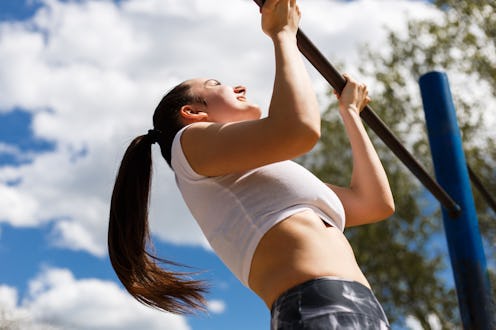
The next time you grab a pull-up bar, pay attention to where you place your hands because that can quickly turn a pull-up into a chin-up, and vice versa. While these two exercises look super similar, trainers say there are a few subtle differences that set pull-ups and chin-ups apart, especially when it comes to benefits.
The main difference between a pull-up versus a chin-up is your grip. A pull-up uses an overhand grip with your palms facing away, while a chin-up uses an underhand grip with your palms facing in, says TJ Mentus, an ACE-certified personal trainer with Garage Gym Reviews.
To do a proper pull-up, you’d jump up, grab a pull-up bar with an overhand grip, and maneuver your hands until they’re slightly wider than your shoulders. You’d then lift up by pointing your chest towards the bar as you pull your elbows down towards your hips, says Chris Pabon, an elite trainer with FlexIt. The goal with a pull-up is to get your collarbone as close to the bar as possible.
A chin-up is a variation of a pull-up, and one that most people tend to find slightly easier, Pabon tells Bustle. To do a chin-up, you’d grab the bar with an underhand grip with your hands no wider than shoulder-width apart. Then, you’d point your chin up to the bar as you lift yourself, Pabon explains.
While they sound simple in theory, note that both pull-ups and chin-ups are way easier said than done, as both require a ton of strength. That said, both exercises are worth a try, as they come with all sorts of benefits. Here, trainers break down what you need to know about the moves.
The Benefits Of Pull-Ups
Pull-ups mainly help strengthen the muscles of the upper back. “Those looking to focus on lat strength should do pull-ups,” Mentus says, adding that back strength is the key to good posture as well as shoulder stability.
Pull-ups are also a great way to build up strength in the arms (as you might have guessed) since you rely on them to lift your body up. The biceps definitely help you out as you pull, Mentus says, but they also help you maintain control as you slowly lower back down.
Because you have to hang on for dear life against your full body weight, doing regular pull-ups can also improve the grip strength in your hands, which Mentus says helps with other exercises that involve holding onto weights. (Think dumbbell flys and kettlebell swings.)
The Benefits Of Chin-Ups
With the simple switch from an underhand to an overhand grip on a pull-up bar, you’ll suddenly give your arms much more of a workout. Chin-ups strengthen the muscles in your biceps and forearms thanks to the curling motion as you raise up, Mentus says, which is why you may want to focus on this variation whenever you’re training your arms.
Like pull-ups, chin-ups can also improve your posture by strengthening the muscles in your back and shoulders. That’ll make it easier to hold your shoulders back and down, Mentus says. Specifically, chin-ups work your latissimus dorsi, Pabon adds, aka the big muscle across your back.
Chin-Ups Vs. Pull-Ups
Both pull-ups and chin-ups are pulling exercises that strengthen the arms and back, Mentus says, which can improve your posture and shoulder stability. “The difference is that a chin-up will place more emphasis on the biceps,” Mentus says. “Chin-ups are also easier for most people because the biceps help out more.”
Since the different hand positions target the muscles in your arms and back differently, Mentus suggests adding both moves to your workout routine. “Doing both will also help to prevent muscle imbalances,” he notes.
If pull-ups or chin-ups sound too tough, never fear: Both moves are also easily modified, whether that means doing fewer reps as you build your strength or using a pull-up band to help you out with the up-down motion, says Pabon.
While you can do both exercises in the same workout session, you might end up choosing one over the other due to personal preference. “For most people, the real differences come down to comfort,” says Pabon. “No one’s going to do something that is uncomfortable or that hurts, so find which one works for you and hit the bar.”
Studies referenced:
Ronai, P. (2014). The Pull-up. Strength and Conditioning Journal. doi: 10.1519/SSC.0000000000000052
Youdas, JW. (2010). Surface electromyographic activation patterns and elbow joint motion during a pull-up, chin-up, or perfect-pullup™ rotational exercise. J Strength Cond Res. doi: 10.1519/JSC.0b013e3181f1598c.
Sources:
TJ Mentus, ACE-certified personal trainer with Garage Gym Reviews
Chris Pabon, trainer with FlexIt